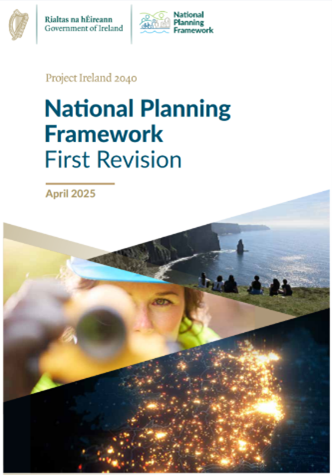14. Final First Revision to the National Planning Framework (NPF) (2025)
On the 30th of April 2025, the Houses of the Oireachtas approved the First Revision of the National Planning Framework (NPF), in accordance with Section 20C(8) of the Planning and Development Act 2000 (as amended). The First Revision of the NPF is available to view here.
The Revised NPF focuses on updates to the previous version to reflect significant and sustained population growth observed since the publication of the original document in 2018 and updates to Government policy, amongst other factors. The revision is also brought about to accelerate much-needed housing delivery in the coming years, according to the Government.
The approval of the updated NPF follows a significant process of stakeholder engagement and national public consultation from July to September 2024.
This JSA Insight updates our previous Insight No. 6 on the Draft Revision, by presenting the main changes incorporated into the finalised First Revision of the NPF following the public consultation period:

Main Changes from the Previous NPF
- National Population Growth Target increased from 5.8 million to 6.1 million by 2040.
- Represents an additional c. 250,000 people compared with the original NPF.
- Total increase of 950,000 people over 2022 Census population figures.
Amends regional population growth targets as follows:
Eastern and Midland Region (EMRA):

Southern Region (SRA):

Northern and Western Region (NWRA):

- Continuation of policy directing 50% of national growth amongst Ireland’s five cities of Dublin, Cork, Limerick, Galway and Waterford.
- Establishes new minimum growth targets for Ireland’s five cities:
- Dublin – 1.56 million by 2040 (+296,000 on 2022)
- Cork – 320,000 by 2040 (+96,000 on 2022)
- Limerick – 150,000 by 2040 (+44,000 on 2022)
- Galway – 122,000 by 2040 (+36,000 on 2022)
- Waterford – 88,000 by 2040 (+28,000 on 2022)
- Outlines a national target of 50,000 additional homes per annum to 2040, or 800,000 additional homes between 2024 and 2040 (compared to 550,000 additional homes between 2018 and 2040).
- Places greater emphasis on the accelerated delivery of transport orientated development (TOD) opportunities at greenfield and brownfield sites adjacent to major public transport hubs in the five cities, suburbs and metropolitan towns.
- In addition, the updated NPF helpfully includes a definition for TOD as follows:
- “a form of urban development that seeks to maximise the provision of housing, employment, public services and leisure space in close proximity to frequent, high quality transport services.”
- Reinforces compact urban form and higher density objectives with greater significance placed on brownfield site regeneration, vacant / derelict site redevelopment, and relocation of existing uses, in existing urban centres is in line with the Sustainable Residential Development and Compact Settlement Guidelines 2024 and Town Centre First policies – in tandem with the policy requiring 40% of all new housing to be built within existing urban footprints (50% in cities / 30% elsewhere)
- The revised NPF also requests that City and County Development Plans improve the identification of brownfield/infill sites, and to map and publish details of such areas as part of the ‘Settlement Capacity Audit’ process.
- Prioritisation of development in areas with existing and planned infrastructure capacity with additional focus on demand management and promotion of key enabling infrastructure. The updated NPF also encourages the maximisation of existing infrastructural capacity in terms of water services through increasing Nature Based Solutions to free up existing capacity in existing combined sewers.
- Improved flexibility in the planning system with focus on performance-led criteria in assessing proposals in comparison to compliance with rigid standards in respect of separation distances, for example.
- Reflects an enhanced focus on climate neutrality and renewable energy development (including biomethane development) working towards a 51% reduction in GHG emissions by 2030.
- Specific plans to facilitate the development of at least 5GW of installed offshore wind capacity by 2030, and the longer-term ambition for over 37GW of offshore renewable energy to be delivered before 2050 are included in the Revised NPF.
- Emphasises importance of ‘Avoid-Shift-Improve’ model to transportation infrastructure development, with particular regard paid to enhanced permeability and the promotion of active travel in reducing transport emissions in tandem with the delivery of the EV Charging Network Plan and advanced availability of shared sustainable travel modes.
- Promotion of improved linkages between green and blue infrastructure spaces and networks, in line with City and County Biodiversity Action Plans.
Conclusions
The Revised NPF is the long-term, 20 year strategy for the strategic planning and sustainable of our urban and rural areas to 2040, and supports compact growth, higher density development, transport-orientated development opportunities, increased infrastructure capacity and renewable energy development. The First NPF Revision has taken the opportunity to improve the consistency of its policies in accordance with other national policy documents including the National Biodiversity Action Plan 2023-2030 and the Climate Action Plan 2024 amongst others. This establishes a more appropriate and robust footing for the Irish planning system going forward.
The approval of the Revised NPF provides the basis for review of and updating of City and County Development Plans to take account of the updated population and housing targets. In this respect, a letter from the Minister for Housing Local Government and Heritage, James Browne T.D., to the City and County Councils was sent on the 16th of May 2025, requesting that all Development Plans be reviewed “to reflect the nation’s updated housing requirements.” It is understood that new Section 28 Planning Guidelines for the rezoning of appropriate and suitable sites are currently being drafted as priority and are to be completed by the end of June / early July. These are likely to require local authorities to zone additional lands for residential development in line with the increased housing targets and population growth. This is a welcome development for future housing delivery and the proper planning and sustainable development of the State.

discuss this insight,
please contact us:

Managing Director

Consultant
